Springtime in south Florida generally means onshore breezes around the clock on the Atlantic coast. These steady breezes tend to push ashore large numbers of Physalia physalis, known as the Portuguese man o’ war, as was the case last weekend at Red Reef Park in Boca Raton:
According to my Witherington guide (Florida’s Living Beaches), April and May are the peak months for both size and abundance of these washed-up siphonophores. Even though it’s not a true jellyfish, the fact that both this animal and the true jellyfish can deliver a painful sting makes the distinction irrelevant in most people’s minds. After all, it’s easier to call something that looks like a jellyfish, floats like a jellyfish, and stings “like a jellyfish,” well, a jellyfish! The fact that it doesn’t really look like a jellyfish if you look closely enough doesn’t really matter to most people; the fact that it floats on top of the water with an inflated gas bag, instead of swimming or floating freely in the water column like a jellyfish doesn’t really matter to most people; the fact that its sting is many times more venomous than that of most jellies doesn’t really matter to most people, either.
The sting alone is enough to discourage most people from looking at it closely enough to notice the other differences between it and the true jellyfish. In fact, the sting is what gives the entire phylum, Cnidaria, which includes such diverse animals as corals, anemones, true jellyfish, and hydrozoans, its name. It derives from the Greek knidē, nettle.
The phylum consists of radially symmetric animals that possess specialized stinging cells called nematocysts:
If collar cells and spicules are defining characteristics of the Phylum Porifera, then nematocysts define cnidarians. These tiny organelles, [like] . . . cocked guns, are both highly efficient devices for capturing prey and extremely effective deterrents to predators. Each contains a coiled, tubular thread, which may bear barbs and which is often poisoned. A nematocyst discharges when a prey species or predator comes into contact with it, driving its threads with barb and poison into the flesh of the victim by means of a rapid increase in hydrostatic pressure. Hundreds or thousands of nematocysts may line the tentacles or surface of the cnidarian. They are capable even of penetrating human skin, sometimes producing a painful wound or in extreme cases, death. (From ADW entry)
So if the sting defines the entire phylum, it’s not too surprising that few people bother to make the distinction between the true jellyfish and the distantly related siphonophores.
Take a look at the pictures below and see if you can tell which one is a “true” jelly:
Did you get it right? All three are coelenterates (another word for cnidarians), but only the last is a “true” jelly, one of the moon jellies seen in a hasty snapshot from a pelagic birding trip I took in California last fall. Note how the jellyfish swims under the surface of the water, instead of floating on top, pushed by wind and wave action. Harder to tell at a glance, but true as well, is the fact that this is a unitary animal, rather than a colonial “superorganism.”
The first two, the Portuguese man o’ war and the By-the-wind sailor are colonial hydrozoans, “individual” animals composed of several different types of unisexual or asexual polyps and free-swimming sexual medusae. Both of them come in left- and right-sided versions as well. That is, the sail-like structure at the top of the pneumatophore (the gas bag) is angled either to the left or to the right. Thus, a left-sided and a right-sided animal would travel at right angles to each other if pushed by the same breeze. (This means that most mass strandings involve only one or the other body plan; it would be hard for a group of opposite-sided animals to stay together.)
Velella velella, the By-the-wind sailor, is placed by some in the order Athecata, which means “without a theca” (a theca is an enveloping sheath or case, from the Greek thēkē, case). Because athecata is not a monophyletic order, it will most likely change as more becomes known about these organisms. Other taxonomists place V. velella in the now-obsolete order Chondrophora (Greek chondros, grain or cartilage), or the current family (a higher taxonomic unit) Porpitidae. Below is a picture of a by-the-wind sailor that’s been washed up long enough to have lost its blue coloration:
Physalia physalis, the Portuguese man o’ war, is in the order Siphonophora, although it is by no means representative of that order. As far as I know, Physalia is the only genus in the order that floats on the surface of the water, rather than in the water column. There are some amazing creatures in this order that have only recently become better known to science. I can’t do much better than to quote to the aforelinked Casey Dunn:
Siphonophores challenge us to think about what we mean when we call something an individual, a concept that we usually think of as being quite straightforward. Is a single zooid or an entire colony the siphonophore “individual”? The answer is that you have to specify what features you are interested in before you can expect a meaningful answer. Do you mean ecologically? The entire colony functions as a single organism whether it is predator or prey. So the colony is an ecological individual. The same can be said for behavior. How about evolutionarily? There are two different components to this question. If we ask how evolution acts on siphonophores now, they are individuals. All the parts of the colony are genetically identical and the colony lives or dies as a whole (except for the eudoxids described later). So siphonophores are evolutionary individuals with respect to how natural selection shapes them today. The other way to look at evolutionary individuals is by descent. We can do this by taking a look at two animals and asking which structures descend from the same feature of a common ancestor. Just as this leads us to recognize that bat wings are modified arms, it shows that siphonophore zooids are polyps and medusae, structures that can be free living animals in other species. So this argument leads to the conclusion that the zooids of siphonophores are individuals. This is not contradictory to our previous conclusions, we are just looking at a different feature of individuality.
In the case of the man o’war, each colony consists of four distinct polyps, each of which has a special function:
- pneumatophore (float)
- dactylozooids (tentacles for defense and prey capture)
- gastrozooids (feeding)
- gonozooids (reproduction)
Without all four types, this colonial “superorganism” (with apologies to Wilson and Hölldobbler) would not function. Below is a picture of several men o’ war that wound up dying in the same bed of sargassum:
Whether you consider each colony as an individual or a plurality, there are at least three of them in that photo.
The by-the-wind sailor is also a colonial animal, rather than a single individual like the jellyfish, but its composition is slightly less famous than its larger cousin, and I’m nearing 2000 words, which makes this blog posting Too Long Already.
I’m belaboring the distinction between these hydrozoans and the other coelenterates because it’s not just an abstraction. It’s grounded in real, physical differences between the two groups. If we limit ourselves to a simple experience (ouch! they both sting! they must both be jellyfish!), or a cursory glance (they all look like gelatinous blobs) we run the risk of building our mental worlds on false grounds. These animals (don’t) swim like jellyfish, (don’t) look like jellyfish, and (do) sting like jellyfish; they are really not jellyfish at all.
Perhaps this tendency to give cnidarians short shrift stems from our landlocked perspective, colored by our evolutionary past. Our distant ancestors left the oceans a long time ago, but even before that, at least as far back as we can reliably speculate, they were unitary beings arranged on a bilaterally symmetric body plan that centered around a spinal column, or notochord (that longitudinal flexible rod of cells that forms the supporting axis of our body). However, only a very few of the organisms on this planet have one. Possessing a backbone is such a distinguishing characteristic that this one character defines the phylum Chordata within the animal kingdom.
But there are many, many other phyla within the kingdom Animalia: “the” inverterbrates, as we call them, as if the fact that they don’t have a backbone somehow is sufficient to characterize them in binary opposition to our own group, the vertebrates. Remember, though, the absence of a character is not a defining characteristic of any taxon, so to lump all animals without a backbone into one category defies logic. (Think: “Man is the animal without wings.”) However, since we are the ones defining the taxa, and we have backbones, it’s hard not to put “like-us” into one category, and “not-like-us” into another. Doing so, though, creates a hugely disproportionate grouping because, depending on your favorite taxonomy, invertebrates comprise anywhere from 13 of 14 (Wikianswers), up to 36 of 37 (Margulis & Chapman) of the phyla in the kingdom Animalia. (And if you’re a phylogenist or cladist, you don’t even bother with these considerations, you just add grouping after grouping. This one from the Tree of Life web project seems pretty accurate.)
And all of these phyla are arranged along a stunning variety of alternate body plans. The cnidarians, or coelenterates, are one of those phyla that tax our interpretive powers to the utmost. For years we didn’t even know the body plan of many of them because their bodies are so fragile they exploded in our nets, or even just at the approach of the lights of a submersible! Our perspective as terrestrial animals that only occasionally venture into nearshore marine environments has really slowed our understanding of this group of animals, except for those few that are hardy enough to exist at or near the surface.
Someday, after I get an underwater camera rig, I might delve more deeply into those other colonial cnidarians, the corals, with their symbiotic relationships with algae called zooxanthellae. But sea level rise and rising ocean temperatures might drive these fragile ecosystems to extinction before I can get around to buying a waterproof digicam and time to learn how to dive. So for now, I’ll concentrate on those organisms that I can find in the tidal wrack after a strong easterly blow like we’ve had for the past week or so. More on what I found later…
References
Dunn, C. “Siphonophores” (On-line), Siphonores. Accessed April 12, 2010 at http://siphonophores.org/SiphOrganization.php
Hammond, G. 2009. “Hydrozoa” (On-line), Animal Diversity Web. Accessed April 12, 2010 at http://animaldiversity.ummz.umich.edu/site/accounts/information/Hydrozoa.html.
Myers, P. 2001. “Cnidaria” (On-line), Animal Diversity Web. Accessed April 12, 2010 at http://animaldiversity.ummz.umich.edu/site/accounts/information/Cnidaria.html.
Tree of Life Web Project. 2002. Animals. Metazoa. Version 01 January 2002 (temporary). Accessed April 13, 2010 at http://tolweb.org/Animals/2374/2002.01.01 in The Tree of Life Web Project, http://tolweb.org/
Witherington, B. and Witherington D. 2007. Florida’s Living Beaches: A Guide for the Curious Beachcomber. Sarasota, FL: Pineapple Press.


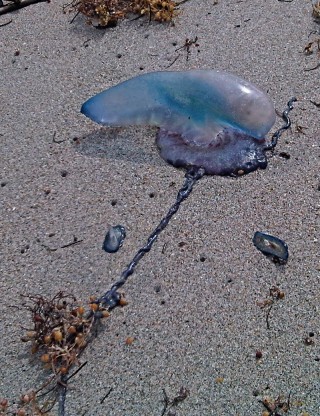
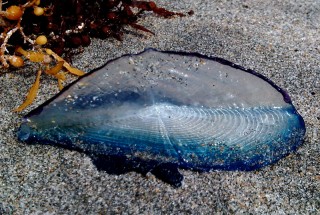
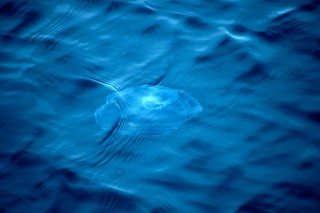
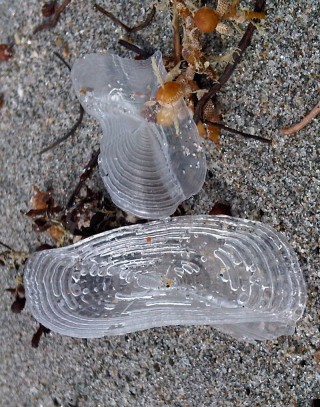
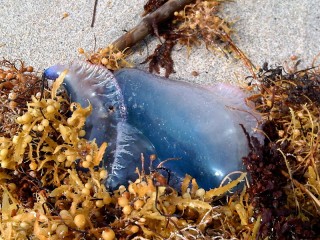
Great article! Thank you for putting this together. I shared this out to my Surf Ministry because the beach at La Jolla Shores (San Diego, CA) was littered with the remains of hundreds of By-the-Wind Sailors. We thought they were related to Man o’War but could not recall the name.
Thanks for visiting, and for commenting! This post was written so long ago, I read it as though it were all brand new to me! (And discovered problems with the paragraphing while doing so, even if the info in it is–I hope–still valid.)
Cheers!